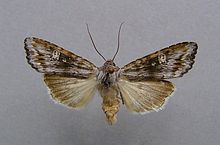Lithomoia solidaginis
Appearance
| Lithomoia solidaginis | |
|---|---|

| |
| Scientific classification | |
| Kingdom: | |
| Phylum: | |
| Subphylum: | |
| Class: | |
| Order: | |
| Family: | |
| Genus: | |
| Species: | L. solidaginis
|
| Binomial name | |
| Lithomoia solidaginis (Hübner, [1803])
| |
| Synonyms | |
| |
The golden-rod brindle (Lithomoia solidaginis) is a moth of the Noctuidae family. It is found in most of Europe, except the Iberian Peninsula, Ireland, Iceland and the western and southern part of the Balkan Peninsula.


The wingspan is 45–51 mm. Adults are on wing from August to September or early October and are attracted to sugar and occasionally to light. There is one generation per year.
The larvae feed on Myrica gale, Ribes uva-crispa, Sorbus aucuparia, Amelanchier confusa, Calluna, Vaccinium species (including Vaccinium myrtillus and Vaccinium uliginosum), Andromeda polifolia, Ledum palustre and Pedicularis palustris.
It hibernates as an egg and pupates in a cocoon under moss or soil.
External links
Wikimedia Commons has media related to Xylena solidaginis.
- Golden-rod Brindle up UKmoths
- Xylena (Lithomoia) solidaginis up Fauna Europaea
- Xylena solidaginis up Lepiforum.de
